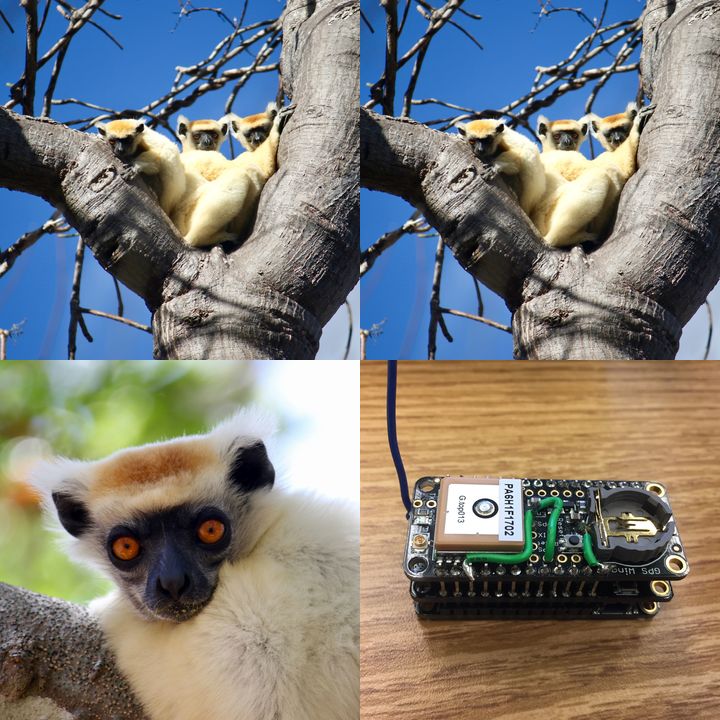Customizable Tracking Collars
The Problem
One of the most difficult obstacles researchers must face when studying mammal species is effective, long-term tracking. Various mammal species of conservation concern such as elephants, wild dogs, bats, cetaceans, chimps, lions, wolves, and lemurs exhibit fluctuations in group size and social proximity that make them difficult to study. Effective tracking can be nearly impossible due to logistical challenges and high cost of commercially available tracking equipment. This challenge in efficiently tracking wildlife has lead to difficulty in understanding the impacts of global changes, such as disease transmission, habitat fragmentation, and climate change, on the behavior of wildlife species. To combat this issue, more advanced, customizable, cost effective tracking technology is needed. As a PhD student, I have run into the obstacle of expensive tracking technology when seeking to understand the ranging behavior and habitat needs of a critically endangered lemur species (golden-crowned sifaka) in northern Madagascar. Madagascar, an island off the coast of southeast Africa, is one of the world’s “richest” biodiversity hotspots, yet also one of the most imperiled. This species displays a flexible behavioral strategy called “fission-fusion”, which results in individuals periodically separating from group members and rejoining after separation. More advanced tracking technology would allow myself and other researchers to conserve this species, along with many others worldwide.
Our Proposal
Traditionally, studies examining group movements and behavior of primates and various other mammals have taken a “boots and binoculars” approach. While this can be effective, it is very difficult and the data are limited by the amount of time the investigator can spend monitoring the group. Further, studying animals when groups are constantly fluctuating in size and composition is nearly impossible. Technology in the form of commercially available tracking equipment is promising but limited due to high cost and specific needs of different species. To address this issue, I am designing a modular, open-source tracking collar, FitPET (“FITness, Proximity, Energetics, and Tracking”), that is capable of capturing data specific to spatial behavior and can provide truly innovative insights into how habitat structure and other variables influence animal groups. Our prototypes will be equipped with various sensors including GPS chips, radio chips, heart rate monitors, thermometers, force meters, luminance sensors, and accelerometers. Depending on the sensors included, the collars could collect precise quantitative measurements such as group member proximity, locomotion, energy expenditure, heart rate fluctuations, exposure to light, etc. Researchers will be able to customize the collars to include sensors salient to their particular needs. All components of the prototype will be purchased from Adafruit, an open-source hardware company, so that users can construct their own collars.
We Assume that...
1) I assume that the FitPET devices will be safe for longterm use in small, medium, and large terrestrial mammals.
2) I assume that the solar panels we intend to use will recharge the battery and result in the collars staying recharged for several years.
3) I assume that the products we will use from Adafruit will be durable enough to withstand fluctuating temperatures, slight humidity, and outdoor wear and tear.
4) I assume that the design team will be able to create an external case that successfully weather-proofs the FitPET device.
5) I assume that the remote data retrieval and reprogramming function will work as well as commercially available tracking collars.
6) I assume that there will be great demand for the FitPET devices due to their low cost and salient design.
Constraints to Overcome
The top constraints I will address are the exorbitant cost and short lifespan of traditional tracking collars. Due to the design/testing costs and limited market of commercials tracking collars, devices equipped with a GPS chip cost upwards of $1,500. As a result, most projects or organizations are only able to collar a select few individuals. Our FitPET devices will cost roughly $200. The lifespan of a traditional collar is also a constraint because it depends on the size of the animal and the subsequent battery that can be used. A general small mammal collar (~150g) cannot last for more than 12 months with roughly one GPS location/hour. Due to the solar panels we are incorporating in our devices and the power optimization of our components, our collars are intended for use until the electronics fail. The FitPET collars are designed to turn off when the battery gets to critically low levels and will recharge until the battery is functioning.
Current Work
Our first goal is gathering our team to build the FitPET devices and extensively bench testing them. This involves determining proper sensors and solar panels, optimizing power consumption, and testing for weather and temperature resistance. Our second goal is testing the collars on captive lemurs to ensure they are safe (and applying them to wild lemurs in Madagascar). The data will ultimately be used to inform conservation management plans of the species. Our final goal is dissemination and expansion of our tracking devices. Once successful lemur validation has occurred, we will work to disseminate our technology to other faculty and students at Virginia Tech (and eventually to other schools in the United States and worldwide). We will create a website with detailed “instructables” to share our methodology, materials list, computer code, and design specifications with other researchers. This will ensure that our product will have broad implications in studying other wildlife systems.
Current Needs
In regards to project needs, my team is in need of funding and additional technical expertise. Each of our collars are equipped with two small solar panels, however, we are still having difficulty with the circuit system and determining the most effective way to keep the collars functioning on a long term basis. We would also greatly benefit from communication support in order to form collaborations with other biologists who are interested in applying novel tracking technology to their studies.
